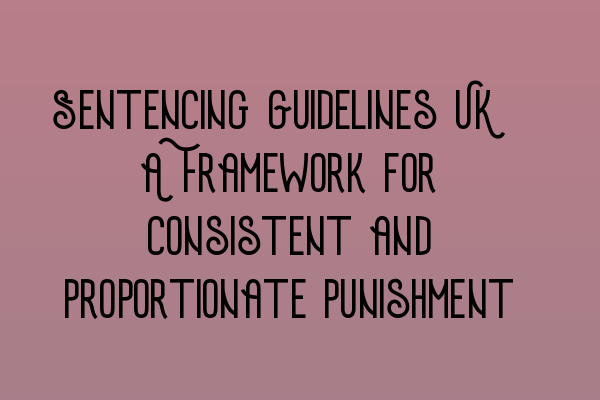Sentencing Guidelines UK: A Framework for Consistent and Proportionate Punishment
When it comes to criminal law in the UK, it is essential to have a framework that ensures consistent and proportionate punishment for offenders. This is where sentencing guidelines come into play. Sentencing guidelines provide a structure for judges and magistrates to follow when determining the appropriate punishment for a particular offense.
The Importance of Sentencing Guidelines
Sentencing guidelines serve as a valuable tool in promoting fairness and transparency in the criminal justice system. By providing a set of principles and factors to consider, they help prevent arbitrary decision-making and ensure that similar offenses are treated with comparable severity. These guidelines are based on extensive research, legal precedents, and public input, making them a comprehensive and reliable resource.
It is crucial for legal professionals, aspiring solicitors, and anyone interested in criminal law to understand the principles that underpin sentencing guidelines. Familiarity with these guidelines can help in analyzing case law, preparing effective legal arguments, and ultimately securing fair outcomes for clients.
The Structure of Sentencing Guidelines
The Sentencing Council in the UK publishes guidelines for different types of offenses, ranging from theft and assault to drug offenses and sexual offenses. Each guideline consists of several sections that provide guidance on determining the appropriate punishment.
The first section of the guideline typically outlines the different categories of the offense, taking into account the seriousness of the harm caused, the level of culpability of the offender, and any aggravating or mitigating factors. These categories provide a starting point for determining the appropriate sentence.
Next, the guideline provides a range of sentences for each category, including custodial sentences, community orders, fines, and other ancillary orders. This range reflects the statutory maximum and minimum sentences, ensuring that the punishment remains proportionate to the offense committed.
The guideline also highlights specific aggravating and mitigating factors that should be taken into account. These factors may include the offender’s previous convictions, the impact of the offense on the victim, any remorse or lack thereof shown by the offender, and any attempts made to make amends.
Furthermore, the guideline emphasizes the importance of considering individual circumstances, including the age, mental health, and personal circumstances of the offender. This allows for a more nuanced approach to sentencing, ensuring that each case is treated on its merits.
Benefits of Using Sentencing Guidelines
The use of sentencing guidelines offers numerous benefits to the criminal justice system as a whole:
- Consistency: Sentencing guidelines promote consistency in punishment across different courts and judges, ensuring that similar offenses receive comparable sentences.
- Transparency: Guidelines provide a transparent framework for determining sentences, allowing offenders, their legal representatives, and the general public to have a clear understanding of how sentences are arrived at.
- Proportionality: By considering the seriousness of the offense, the level of culpability, and any aggravating or mitigating factors, guidelines ensure that the punishment is proportionate to the harm caused.
- Accountability: Sentencing guidelines hold judges and magistrates accountable for their decisions, as they are required to provide reasons for deviating from the recommended range.
It is worth noting that sentencing guidelines are regularly reviewed and updated to reflect changes in legislation, societal attitudes, and sentencing practices. This ensures that the guidelines remain relevant and in line with the evolving landscape of criminal law.
Aspiring solicitors, legal professionals, and individuals interested in the criminal justice system can benefit from staying informed about the latest updates to the sentencing guidelines. This can be achieved through ongoing professional development, attending relevant training courses, and staying up to date with legal publications.
In conclusion, sentencing guidelines play a vital role in promoting consistency and proportionality in the criminal justice system. They provide a structured framework for judges and magistrates to follow when determining the appropriate punishment for different offenses. By adhering to these guidelines, legal professionals can ensure that their clients receive fair and just outcomes.
For more information about the SQE Criminal Law & Practice Law UK, please check out our related articles and resources:
